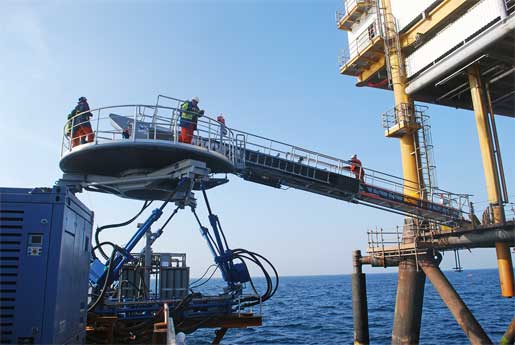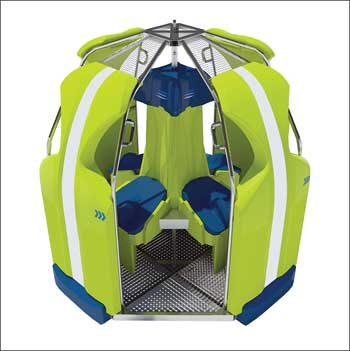A Dutch invention makes offshore access from a moving vessel to a fixed platform much safer. Meanwhile, an alternative to the personnel net has just undergone a major revision.
Perry A. Fischer, Editor
One of the most dangerous offshore personnel transfers - and one that this editor has had the unfortunate luck to have experienced firsthand - occurs between a fixed platform and a moving vessel, such as when transferring between a tender and a drilling platform, via the appropriately named
“widow-maker.”
Last December, a new offshore access system for safely transferring marine personnel was successfully tested at the Shell-owned Offshore Wind Farm at Egmond aan Zee (OWEZ). Developed at Delft University of Technology and called Ampelmann, the technology consists of a six-leg hydraulic motion compensation platform with a telescoping access bridge mounted on top, providing safe and easy access to any offshore installation.
The new personnel transfer system was completed only one year after the first design appeared on the drawing board. The project team launched the Ampelmann Company Ltd., which is one of most promising spin-off companies of the Delft University of Technology in recent years. The transfer device aims to secure a spot wherever there is a need to transfer between a moving vessel and a fixed, or virtually fixed, spar, platform, windmill or similar structure.
On the vessel end, the six hydraulically powered legs serve to compensate for vessel heave and roll motions, keeping it virtually motionless at all times, even in rough sea states (up to Hs = 2.5 m). The concept is based on flight simulator technology. However, instead of creating airplane motions, it is used to cancel out the vessel motions using a dedicated motion sensor that is constantly measuring ship movement. Providing full motion compensation in all six degrees of freedom, the motionless transfer deck allows personnel to safely access any offshore structure through a telescoping access bridge, Fig. 1.
 |
|
Fig. 1. The new personnel transfer walkway has a motion-compensated platform that resides on the end of the vessel, compensating for motion in all six degrees of freedom, keeping the platform steady. The walkway telescopes to allow the vessel to keep some distance from the fixed platform (in this case, Wintershall’s P14-A platform) in rough seas.
|
|
This totally new concept of using motion compensation for safe ship-based offshore access is an alternative to the costly and hazardous use of helicopters. This alternative does not require any adaptation to offshore structures and can be installed as “plug and play” on even small, non-DP vessels.
In May of this year, the system was installed on SMIT’s Taklift 4 sheerleg barge, which was tending Wintershall’s P14-A platform. The unit transferred the first of six crew members to the balcony at 12 m above MSL for preparations of the decommissioning of the platform. On subsequent days, the Ampelmann provided safe access to the spider deck for a 20-person crew three times a day. A summer storm was encountered, with wind speeds reaching Beaufort 7 and a significant wave height up to 3 m. Only 3 hr of downtime were recorded compared to an estimated 4 days of downtime if a normal gangway had been used.
The first commercial units just became available. The widow-maker’s days are numbered.
Crane-based personnel transfer carrier undergoes a significant revision. Since it was first introduced to the offshore industry over 13 years ago, the Frog has been the only challenger to the Billy Pugh personnel transfer net. The Billy Pugh Co. has its own improvement to its extraordinarily successful personnel transfer net - the X-904 (see December 2007 World Oil, pg. 39) - which recently received the American Bureau of Shipping’s Type Approval. The approval means that ABS certifies that enrolled manufacturers are capable of consistently producing a product in compliance with product specifications.
Reflex Marine, maker of the Frog, just launched a new transfer capsule for crane lifting of personnel off of a vessel. Called the TORO, it has some safety enhancements not found on the Frog, which are a result of client input. It is more cost-effective and convenient to use and, having been optimized for shipping and storage with a 61⁄2-ft (2 m) square footprint, fits into a standard shipping container. The goal was to increase the overall adoption rate of higher specification equipment and globally protect more workers from unnecessary injury.
 |
|
Fig. 2. A new capsule for crane lifting of personnel off of a vessel places an impact barrier in front of the passenger, has hand holds and may not require seatbelts, depending on local regulations.
|
|
The new capsule can carry up to four passengers and, like its predecessor, protect them from side impact and heavy landings, although it has less impact resistance than the Frog when setting down in rough seas. It is buoyant and self-righting, yet will still allow fast loading and unloading of personnel. The new capsule has an ergonomic seat design (Fig. 2) that allows it to be used without seatbelts (subject to company policy and local legislative requirements). The new capsule will be certified with CE marking and ABS Type Approval. There will be a product launch event for the TORO in January 2009 in Aberdeen. 
|




